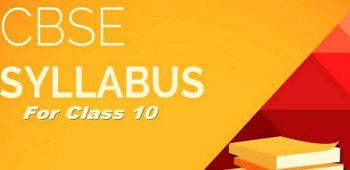ECONOMICS AT SENIOR SECONDARY STAGE
At senior secondary stage, the learners are in a position to understand abstract ideas, exercise the power of thinking and to develop their own perception. Therefore in CBSE Economics syllabus, the learners are exposed to the rigour of the discipline of economics in a systematic way.
ECONOMICS, A REALITY
It is imperative to provide an opportunity to students to acquire analytical skills to observe and understand the economic realities through their own experiences.
Name of the units and their weightage in Board Exam
|
Units |
|
Marks |
Periods |
|
Part A |
Introductory Microeconomics |
|
|
|
|
Introduction |
4 |
8 |
|
|
Consumer’s Equilibrium and Demand |
13 |
32 |
|
|
Producer Behaviour and supply |
13 |
32 |
|
|
Forms of Market and Price Determination under perfect competition with simple applications |
10 |
28 |
|
|
|
40 |
100 |
|
Part B |
Introductory Macroeconomics |
|
|
|
|
National Income and Related Aggregates |
10 |
28 |
|
|
Money and Banking |
6 |
15 |
|
|
Determination of Income and Employment |
12 |
27 |
|
|
Government budget and the economy |
6 |
15 |
|
|
Balance and Payments |
6 |
15 |
|
|
|
40 |
100 |
|
Part C |
Project Work |
20 |
20 |
Details of topics and sub-topics to be covered in each unit
Part A: Introductory Microeconomics
Unit I: Introduction
Meaning of microeconomics and macroeconomics; positive and normative economics.
What is an economy? Central problems of an economy: what, how and for whom to produce; concepts of production possibility frontier and opportunity cost.
Unit II: Consumer’s Equilibrium and Demand
Consumer's equilibrium - meaning of utility, marginal utility, law of diminishing marginal utility, conditions of consumer's equilibrium using marginal utility analysis.
Indifference curve analysis of consumer's equilibrium-the consumer's budget (budget set and budget line), preferences of the consumer (indifference curve, indifference map) and conditions of consumer's equilibrium.
Demand, market demand, determinants of demand, demand schedule, demand curve and its slope, movement along and shifts in the demand curve; price elasticity of demand – factors affecting price elasticity of demand; measurement of price elasticity of demand – percentage-change method.
Unit III: Producer Behaviour and Supply
Meaning of Production Function – Short-Run and Long-Run
Total Product, Average Product and Marginal Product.
Returns to a Factor
Cost: Short run costs - total cost, total fixed cost, total variable cost; Average cost; Average fixed cost, average variable cost and marginal cost-meaning and their relationships.
Revenue - total, average and marginal revenue - meaning and their relationship.
Producer's equilibrium-meaning and its conditions in terms of marginal revenue-marginal cost. Supply, market supply, determinants of supply, supply schedule, supply curve and its slope, movements along and shifts in supply curve, price elasticity of supply; measurement of price elasticity of supply - percentage-change method.
Unit IV: Forms of Market and Price Determination under Perfect Competition with simple applications
Perfect competition - Features; Determination of market equilibrium and effects of shifts in demand and supply.
Other Market Forms - monopoly, monopolistic competition, oligopoly - their meaning and features.
Simple Applications of Demand and Supply: Price ceiling, price floor.
Part B: Introductory Macroeconomics
Unit 5: National Income and related aggregates
Some basic concepts: consumption goods, capital goods, final goods, intermediate goods; stocks and flows; gross investment and depreciation.
Circular flow of income (two sector model); Methods of calculating National Income - Value Added or Product method, Expenditure method, Income method.
Aggregates related to National Income:
Gross National Product (GNP), Net National Product (NNP), Gross and Net Domestic Product (GDP and NDP) - at market price, at factor cost; Real and Nominal GDP.
GDP and Welfare
Unit 6: Money and Banking
Money - meaning and supply of money - Currency held by the public and net demand deposits held by commercial banks.
Money creation by the commercial banking system.
Central bank and its functions (example of the Reserve Bank of India): Bank of issue, Govt. Bank, Banker's Bank, Control of Credit through Bank Rate, CRR, SLR, Repo Rate and Reverse Repo Rate, Open Market Operations, Margin requirement.
Unit 7: Determination of Income and Employment
Aggregate demand and its components.
Propensity to consume and propensity to save (average and marginal).
Short-run equilibrium output; investment multiplier and its mechanism.
Meaning of full employment and involuntary unemployment.
Problems of excess demand and deficient demand; measures to correct them - changes in
government spending, taxes and money supply.
Unit 8: Government Budget and the Economy
Government budget - meaning, objectives and components.
Classification of receipts - revenue receipts and capital receipts; classification of expenditure – revenue expenditure and capital expenditure.
Measures of government deficit - revenue deficit, fiscal deficit, primary deficit their meaning.
Unit 9: Balance of Payments
Balance of payments account - meaning and components; balance of payments deficit-meaning.
Foreign exchange rate - meaning of fixed and flexible rates and managed floating.
Determination of exchange rate in a free market.
Prescribed books
- Introductory Micro Economics, Class XII, NCERT
- Macro Economics, Class XII, NCERT
- Supplementary Reading Material in Economics, Class XII, CBSE
Details related to suggested question paper design for class 12 Economics board exam 2017-2018 is available in PDF of the syllabus
TIPS AND TRICKS:
BOOKS TO BE FOLLOWED
- Treat NCERT books as bible as they are according to the syllabus prescribed by the CBSE. CBSE board exams are entirely based on the prescribed syllabus.
- Various reference books are also available in the market which can be referred for more information.
- Some renowned reference books for class 12th Economics books are T.R.Jain & V K Ohri and C B Sachdeva.
- Students Must refer to Byju’s Commerce Books to achieve 100% marks target.
DEFINITIONS & MEANINGS
- Definitions are to be understood properly with the logic and reasoning behind the concept.
- To get full marks you need to memorize the definitions after understanding them so that you can write them in the exam properly.
DISTINGUISH BETWEEN QUESTIONS
- There are lot of Distinguish Between questions which are to be written in tabular form.
- Do not forget to show basis for differences.
GRAPHS, TABLES AND FORMULAS HOLD VERY IMPORTANT POSITION
- In Economics Theories are supported by Tabular and Graphical representation along with the formulas which help us to understand the concepts of economics in an easy manner.
- Students should practice drawing graphs regularly so that they draw correct shapes of various curves all the time. Use pencil for this purpose.
- Tables are very important and include calculations as well as application of formulas. You should practice them along with graphs.
- Students should NOT mug up those formulas and should understand how that formula is derived and what purpose it is made for. Once you understand the formulas prepare a chapter wise formula sheet and revise them regularly.
- Special focus has to be given while practicing tables and graphs.
NUMERICALS
- Numericals in Economics are very important for both Micro as well as Macro economics.
- Lot of questions are asked in the exam from chapters like elasticity of demand and supply, Revenues and Costs, National income etc
- Practicing them on regular basis is must for students.
NOTES
- You should make your own chapter wise notes.
- Concepts which you find difficult to understand mark them with RED colour.
- If you get stuck while solving questions at some typical point you should note those typical points for later revision. It will help you later on in the exam.
REVISION
- Bring together all your notes, practice registers and formula sheets and start revising as proper Revision is the key for success in any exam.
- Allocate the time available between all the chapters and start solving those questions which you found difficult to solve while practicing.
- Also revise those concepts which you found hard to understand and marked earlier.
PRACTICE FROM PAST YEARS’ PAPERS
- Solving past years’ examination papers is the key of success to every topper provided that is done keeping the time in mind.
- Get a past years’ paper, set your clock and solve that paper within 3 hours.
- This practice will help you to manage your time effectively during the examination and thus you will finish your exam in the allotted time.
- This practice gives you the idea about the pattern of questions, typology and methodology of how examiners set the question papers.
SOLVING SAMPLE PAPERS IS A GREAT IDEA
- Solving sample papers give a great chance to evaluate your level of understanding of the subject.
- There are lot of sample papers available in the market from different publishers.
- Do not forget to solve Byju’s Economics Sample papers for class 12th.




















Comments